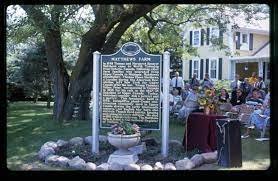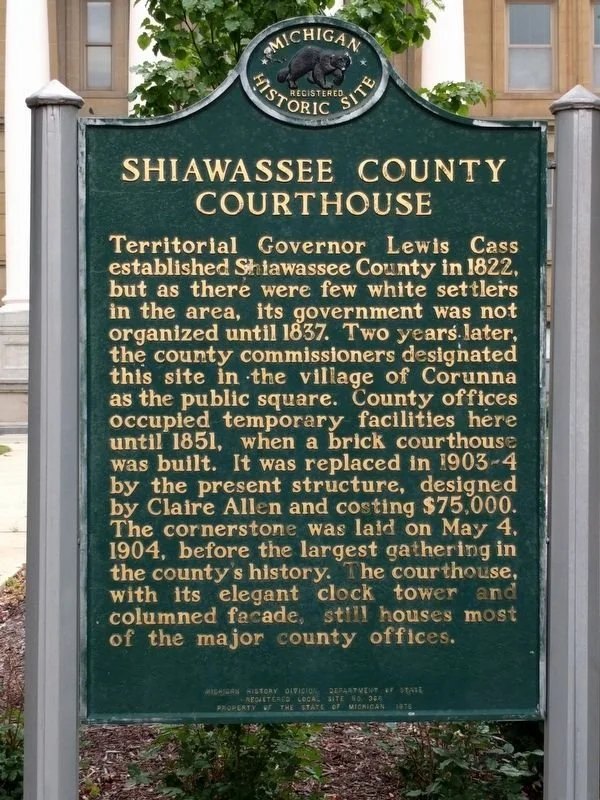Sport
The tug Sport, one of the nation’s earliest steel-hulled vessels, was built for lumber and steel entrepreneur Eber Brock Ward in 1873 by the Wyandotte Iron Ship Building Works in Wyandotte, Michigan. For forty-seven years the tug towed, salvaged, and aided vessels in distress. Frank E. Kirby designed the tug and later became a nationally known naval architect recognized for designing large, elegant sidewheel passenger steamers and ice-breaking car ferries, such as Chief Wawatam.
Village of Cash
Named after early settler Edward Cash, the village of Cash was founded in 1851. In 1868, seven Cash residents voted to found Watertown Township to govern and serve the quickly growing area. Each man who voted held at least one township post. In 1881, Cash survived wildfires that swept across the entire county in five hours. The arrival of the railroad in nearby Watertown in 1912 ended Cash’s role as an important commercial center in the region.
Matthews Farm
In 1848 Thomas and Margaret Spencer Matthews came to Worth Township from Ontario, Canada, following other farm families who migrated from Upper Canada to Michigan. Matthews’s grandfather, Thomas Elmes Matthews, a Loyalist during the American Revolution, left New York for Upper Canada after the war. Young Thomas’s father, Peter, was executed in Toronto in 1838 for his role in the 1837-38 Rebellion of Upper Canada. Today historians consider him a patriot and a martyr.
Trinity Episcopal Church
This tall stately Gothic Style church with its elegant wood interior was built in 1874 during Sanilac County’s great lumbering era. The Reverend A. B. Flower came to Lexington as a missionary in 1869 and started this congregation known as the Church of the Good Shepherd. Among its active members was Mary Moore who married Albert Sleeper, governor of Michigan from 1917 to 1920. Sleeper served as vestryman and warden of the church until moving to Bad Axe. Since 1972 this has been the Lexington Chapel of Trinity Episcopal Church.
Loop-Harrison House
This Second Empire style mansion was built in the 1870s by Doctor Joseph Loop. A native of New York, Loop moved to Oakland County, Michigan, in 1843. He and his wife, Jane Gardner Loop pioneered this land in Sanilac County in 1854, and after graduating from the University of Michigan’s medical department in 1855, he opened a practice in Port Sanilac. When this home was built, he kept an office on the lower floor, and serviced a forty-mile circuit, bringing medical care to much of the county.
Trinity Church
This picturesque cobblestone building constructed in 1898 serves as the Croswell chapel of the Trinity Episcopal Church. Its interior features wooden arches and a rood screen between the nave and the chancel.
The Great Storm of 1913
Sudden tragedy struck the Great Lakes on November 9, 1913, when a storm, whose equal veteran sailors could not recall, left in its wake death and destruction.
The Brown City Banner
Published under the motto “Our Community is our Hive. The Rights of the People, our Queen,” The Brown City Bee debuted on January 23, 1891. Owner James A. Menzies named the newspaper for the “business-like fellow” who ensures “that matters are kept `humming’ about him.” He renamed the paper The Brown City Banner in December 1891.
Masonic Temple & Town Hall
The Sanilac Masonic Lodge was organized in 1868. In 1883 lodge members and township officials agreed to build a combined township and Masonic hall on land donated by Christopher Odfield, a Mason. The foundation was built with three-foot-thick walls to provide refuge from future forest fires. When the cornerstone was laid on July 1, 1884, crowds turned out for the event, which was highlighted by Masonic ritual.
Flint & Pere Marquette Railroad Depot
The first twenty-five miles of track for the Port Huron and Northwestern Railroad opened from Port Huron to Croswell in 1879. Marlette citizens lured the railroad by raising $15,000 toward construction of the tracks. The line extended from Saginaw Junction in St. Clair County to Marlette in January 1881, and the Marlette to Mayville line opened in the fall.
Buel Methodist Episcopal Church
This handsome building was the first church erected in Buel Township. Known as the Buel United Methodist Church, it was dedicated on December 3, 1882.
Shiawassee County Courthouse
The cornerstone was laid on May 4, 1904, before the largest gathering in the county’s history. The courthouse, with its elegant clock tower and columned facade, still houses most of the major county offices.
Shaftsburg School/Woodhull Township Hall
When they were not needed at home, most children attended a one-room school about a quarter-mile west of here, just north of Beard Road. By the early 1880s, enrollment had surpassed the building’s capacity which then led to this two-room school house.
Saint Mary's Church
In 1870 Father Joseph Kraemer became pastor of a Catholic mission at Corunna that included all of Shiawassee County. In 1874 he assisted Antrim Township Irish Catholics in purchasing the Alling Schoolhouse, which he dedicated as a church.
Michigan's First Coal Mine
Alexander McArthur of Corunna discovered coal on the banks of Coal Creek in 1839. It was part of a large vein that produced coal until after World War II.
Methodist Episcopal Church
In 1837 four couples came to this area, known as Maple River, from Oakland County to claim their newly purchased acreage. They were soon followed by a dozen families. These pioneer farmers chose this vicinity because the very fertile land was well-adapted for grazing and crop production.
Maple River
In 1837 four couples came to this area, known as Maple River, from Oakland County to claim their newly purchased acreage. They were soon followed by a dozen families. These pioneer farmers chose this vicinity because the very fertile land was well-adapted for grazing and crop production.
Knaggs Bridge Area
Archaeological evidence indicates men lived in this area before the time of Christ. Chippewa Indians settled here sometime before 1790. Their village was called Kechewandaugoning, which is said to mean "Big Salt Lick."
Judd's Corner
Known more recently as Juddville, Judd’s Corners was first settled in 1853 when Connecticut native John Judd purchased four hundred acres of land encompassing this area from the Hazelton brothers, who owned much of the township.
Herman C. Frieseki/Frederick Carl Frieseke
Herman C. Frieseke built this house in 1872. The bricks used were from the tile and brick factory that he and his brother Julius had opened in 1865 beside the tracks of the Detroit, Grand Haven and Milwaukee Railroad.


















